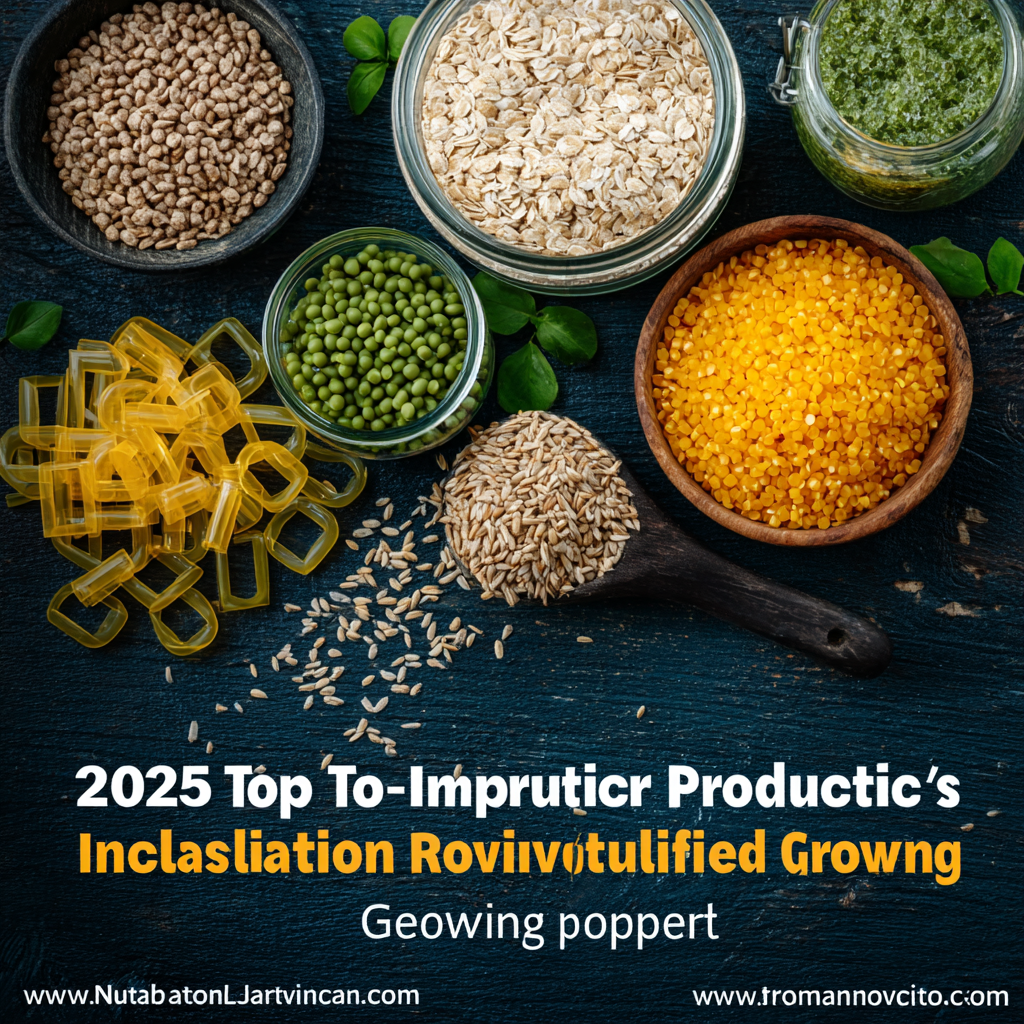2025 Top Plastic Products Trends and Innovations Driving Sustainable Growth
As we move toward a more sustainable future, the plastic products industry is undergoing a significant transformation driven by innovation and environmental consciousness. Renowned plastic products expert Dr. Emily Harrison emphasizes, "The future of plastic products lies in their ability to adapt and contribute to a circular economy." This perspective underscores the importance of advancements that not only enhance the functionality of plastic but also reduce its environmental impact.

In 2025, we can anticipate a surge of trends and innovations that will redefine the landscape of plastic products. From bioplastics made from renewable resources to advanced recycling technologies, industry leaders are actively seeking solutions that support sustainability while meeting consumer demands. The focus is shifting toward products that not only perform well but also leave a minimal ecological footprint.
As we explore the top five trends set to drive sustainable growth in the plastic products sector, it becomes clear that the path forward is about collaboration, innovation, and a commitment to responsible practices. The integration of these trends not only inspires progress within the industry but also fosters a collective effort toward a greener planet.
Innovative Biodegradable Plastics Transforming Consumer Goods Sustainability
The market for biodegradable plastics reached a valuation of $3.76 billion in 2023 and is projected to grow to $3.98 billion by 2024, with an expected value of $6.33 billion by 2032, reflecting a compound annual growth rate (CAGR) of 5.9%. As consumer priorities shift towards sustainability, the demand for innovative solutions in this sector continues to rise. Biodegradable plastics like polylactic acid (PLA) and polyhydroxyalkanoates (PHA) are increasingly being employed in various applications, including food and industrial packaging, shopping bags, and more, addressing both environmental concerns and consumer preferences for eco-friendly products.
In addition to biodegradable plastics, the recycled material packaging market is also witnessing significant growth, estimated to reach $189.9 billion in 2024, with a CAGR exceeding 5.4% from 2025 to 2034. This surge is driven by a growing consumer demand for sustainable packaging solutions. Companies adopting sustainable practices not only mitigate environmental impact but also enhance brand image and reduce costs. The focus on simplicity and minimalism further supports the trend towards sustainable packaging, as businesses strive to deliver innovative, eco-friendly products that resonate with environmentally conscious consumers.
The Rise of Recyclable and Upcyclable Plastic Products in Modern Markets
 As concerns about environmental sustainability continue to rise, the market for recyclable and upcyclable plastic products is gaining momentum. Companies are increasingly designing products that not only minimize waste but also promote circular economy principles. This shift reflects a growing consumer demand for greener alternatives and drives innovation in material science. For instance, bioplastics and composites that can be easily reclaimed and repurposed are becoming more prevalent, allowing businesses to reduce their carbon footprint while appealing to eco-conscious consumers.
As concerns about environmental sustainability continue to rise, the market for recyclable and upcyclable plastic products is gaining momentum. Companies are increasingly designing products that not only minimize waste but also promote circular economy principles. This shift reflects a growing consumer demand for greener alternatives and drives innovation in material science. For instance, bioplastics and composites that can be easily reclaimed and repurposed are becoming more prevalent, allowing businesses to reduce their carbon footprint while appealing to eco-conscious consumers.
Tips for integrating recyclable and upcyclable products into your business strategy include conducting thorough market research to identify consumer preferences and trends. Engaging with suppliers who specialize in sustainable materials is crucial, ensuring that your product lifecycle aligns with sustainable practices. Additionally, consider developing partnerships with organizations focused on recycling and waste management, as they can enhance your brand's credibility and effectiveness in promoting eco-friendly initiatives.
By prioritizing recyclable and upcyclable solutions, businesses not only comply with increasing regulations but also position themselves as leaders in the sustainable market space. Encouraging customers to participate in recycling programs or initiatives can further amplify your brand's impact and foster a sense of community responsibility.
Smart Packaging Solutions: Enhancing Plastic’s Role in Eco-Friendly Logistics
The demand for sustainable packaging solutions is reshaping the plastic industry, particularly with smart packaging technologies that enhance the environmental integrity of logistics. According to a recent report by MarketsandMarkets, the global smart packaging market is expected to reach $46.86 billion by 2028, growing at a CAGR of 9.4% from 2023. These innovations not only improve the visibility and tracking of products throughout the supply chain but also incorporate eco-friendly materials, thus reducing the environmental footprint associated with conventional packaging methods.

One of the most significant trends is the integration of Internet of Things (IoT) technology with traditional plastic packaging, which allows for real-time data monitoring and enhanced inventory management. A study by Smithers found that smart packaging solutions can reduce waste in logistics by as much as 30%, demonstrating a substantial opportunity for businesses looking to minimize their environmental impact. As companies adopt these advanced packaging methods, the need for recyclable and biodegradable plastics becomes increasingly critical, pushing manufacturers towards innovation in sustainable materials that align with circular economy principles.
Advancements in Plant-Based Plastics: Expanding Applications and Adoption
The rise of plant-based plastics marks a significant shift in the materials industry, driven by the urgent need for sustainable solutions. With advancements in technology, manufacturers are increasingly turning to renewable resources such as cornstarch, sugarcane, and other bio-based feedstocks to produce plastics that not only mimic the performance of traditional petroleum-based plastics but also minimize environmental impact. These innovations are expanding applications across various sectors, including packaging, consumer goods, and automotive, paving the way for a more sustainable future.
The adoption of plant-based plastics is further fueled by the growing consumer awareness surrounding environmental issues. More companies are integrating these materials into their product lines, responding not only to regulatory pressures but also to consumer demand for greener alternatives. Innovations in processing techniques and formulations are enhancing the properties of plant-based plastics, making them more versatile and cost-effective. As research continues to advance, we can expect to see even wider acceptance and integration of these sustainable materials within mainstream industries, driving further innovations and contributing to sustainable growth in the plastic products market.
2025 Top Plastic Products Trends and Innovations Driving Sustainable Growth - Advancements in Plant-Based Plastics: Expanding Applications and Adoption
| Trend/Innovation | Description | Potential Applications | Adoption Rate (2025) |
|---|---|---|---|
| Biodegradable Plastics | Plastics that decompose naturally in the environment. | Packaging, disposable cutlery, agricultural films. | 45% |
| Recycled Plant-Based Plastics | Plastics made from recycled plant materials, reducing waste. | Consumer products, automotive parts, home goods. | 30% |
| Plant-Based Composites | Materials combining plant fibers with polymers for enhanced durability. | Furniture, construction materials, automotive interiors. | 25% |
| Edible Packaging | Packaging that can be consumed along with the product. | Food products, snacks, and takeout containers. | 15% |
| Advanced Bio-based Films | Films made from bio-based materials with improved barrier properties. | Food wraps, medical packaging, and electronic covers. | 20% |
Circular Economy Initiatives: Driving Demand for Sustainable Plastic Innovations
The drive towards a circular economy is reshaping the plastic industry, with demand for sustainable innovations at an all-time high. According to a recent report by the Ellen MacArthur Foundation, the global market for recycled plastics could grow to $120 billion by 2025, fueled by consumer preferences for environmentally friendly products. Companies are increasingly recognizing that adopting circular practices not only meets rising consumer expectations but also significantly reduces operational costs and risks associated with raw material sourcing.
As businesses pivot towards circular economy initiatives, they are exploring new technologies and materials that enhance sustainability. For instance, bioplastics derived from renewable resources are gaining traction, and companies are investing heavily in developing advanced recycling techniques. The Global Recycling Foundation reported that these innovations could potentially offset over 300 million tons of plastic waste annually by 2030.
Tips: To stay ahead in the evolving plastic market, businesses should prioritize transparency in their supply chains and invest in research and development for sustainable materials. Engaging with consumers about sustainable practices can also cultivate loyalty and brand trust. Emphasizing collaboration across industries can further drive innovation and amplify the impact of circular economy efforts.


